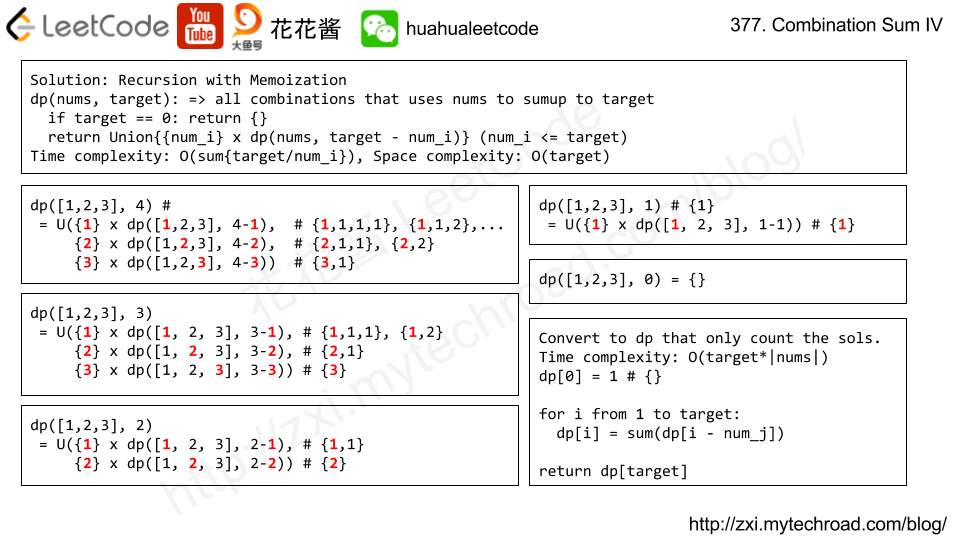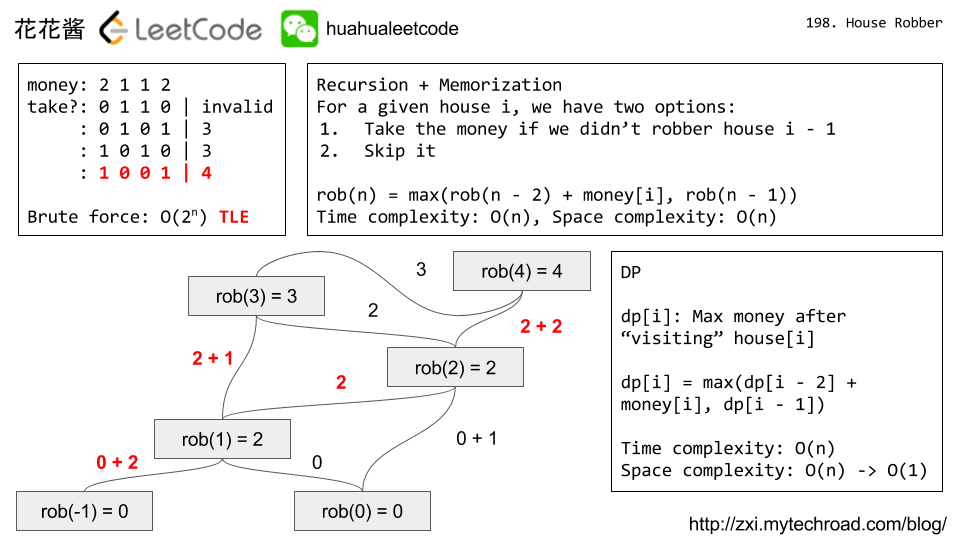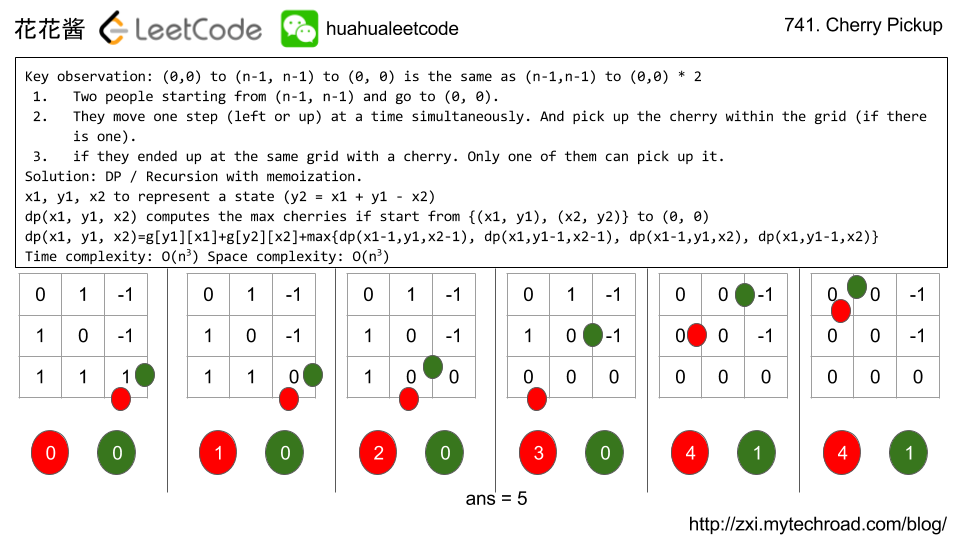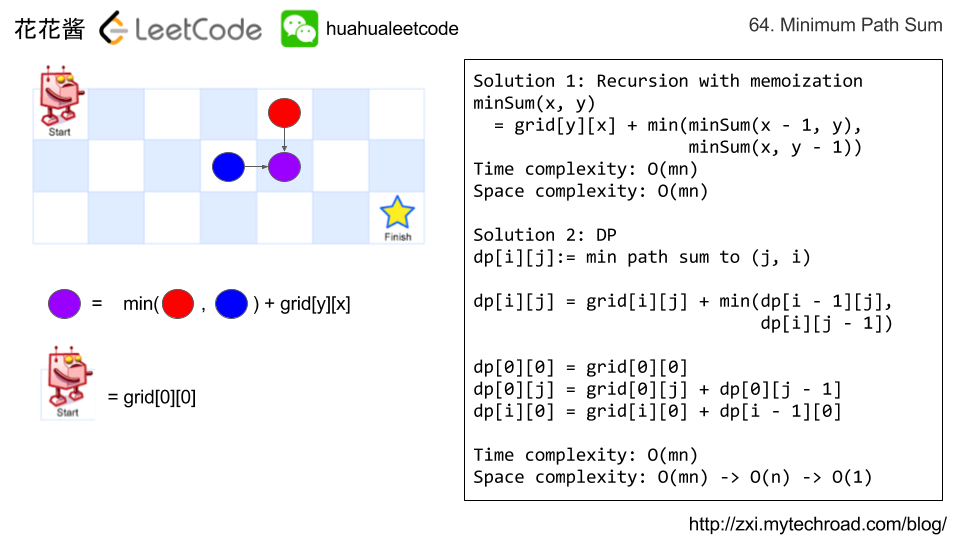题目大意:给你樱桃田的地图(1: 樱桃, 0: 空, -1: 障碍物)。然你从左上角走到右下角(只能往右或往下),再从右下角走回左上角(只能往左或者往上)。问你最多能采到多少棵樱桃。
Problem:
In a N x N grid representing a field of cherries, each cell is one of three possible integers.
0 means the cell is empty, so you can pass through;
1 means the cell contains a cherry, that you can pick up and pass through;
-1 means the cell contains a thorn that blocks your way.
Your task is to collect maximum number of cherries possible by following the rules below:
Starting at the position (0, 0) and reaching (N-1, N-1) by moving right or down through valid path cells (cells with value 0 or 1);
After reaching (N-1, N-1), returning to (0, 0) by moving left or up through valid path cells;
When passing through a path cell containing a cherry, you pick it up and the cell becomes an empty cell (0);
If there is no valid path between (0, 0) and (N-1, N-1), then no cherries can be collected.
Example 1:
Input: grid =
[[0, 1, -1],
[1, 0, -1],
[1, 1, 1]]
Output: 5
Explanation:
The player started at (0, 0) and went down, down, right right to reach (2, 2).
4 cherries were picked up during this single trip, and the matrix becomes [[0,1,-1],[0,0,-1],[0,0,0]].
Then, the player went left, up, up, left to return home, picking up one more cherry.
The total number of cherries picked up is 5, and this is the maximum possible.
Note:
grid is an N by N 2D array, with 1 <= N <= 50.Each grid[i][j] is an integer in the set {-1, 0, 1}.
It is guaranteed that grid[0][0] and grid[N-1][N-1] are not -1.
Idea :
DP
Key observation: (0,0) to (n-1, n-1) to (0, 0) is the same as (n-1,n-1) to (0,0) twice
Two people starting from (n-1, n-1) and go to (0, 0). They move one step (left or up) at a time simultaneously. And pick up the cherry within the grid (if there is one). if they ended up at the same grid with a cherry. Only one of them can pick up it.
Solution: DP / Recursion with memoization.
x1, y1, x2 to represent a state y2 can be computed: y2 = x1 + y1 – x2
dp(x1, y1, x2) computes the max cherries if start from {(x1, y1), (x2, y2)} to (0, 0), which is a recursive function.
Since two people move independently, there are 4 subproblems: (left, left), (left, up), (up, left), (left, up). Finally, we have:
dp(x1, y1, x2)= g[y1][x1] + g[y2][x2] + max{dp(x1-1,y1,x2-1), dp(x1,y1-1,x2-1), dp(x1-1,y1,x2), dp(x1,y1-1,x2) }
Time complexity: O(n^ 3 )
Space complexity: O(n^ 3 )
Solution: DP Time complexity: O(n^3)
Space complexity: O(n^3)
C ++
1
2
3
4
5
6
7
8
9
10
11
12
13
14
15
16
17
18
19
20
21
22
23
24
25
26
27
28
29
30
31
// Author: Huahua
// Runtime: 32 ms
class Solution {
public :
int cherryPickup ( vector < vector < int > > & grid) {
const int n = grid.size();
grid_ = &grid;
m_ = vector < vector < vector < int > > > (
n , vector < vector < int > > ( n , vector < int > ( n , INT_MIN ) ) ) ;
return max ( 0 , dp ( n - 1 , n - 1 , n - 1 ) ) ;
}
private :
// max cherries from (x1, y1) to (0, 0) + (x2, y2) to (0, 0)
int dp ( int x1 , int y1 , int x2 ) {
const int y2 = x1 + y1 - x2 ;
if ( x1 < 0 | | y1 < 0 | | x2 < 0 | | y2 < 0 ) return -1 ;
if ( ( *grid_ ) [ y1 ] [ x1 ] < 0 | | ( *grid_ ) [ y2 ] [ x2 ] < 0 ) return -1 ;
if ( x1 == 0 && y1 == 0) return (*grid_)[y1][x1];
if ( m_ [ x1 ] [ y1 ] [ x2 ] ! = INT_MIN ) return m_ [ x1 ] [ y1 ] [ x2 ] ;
int ans = max ( max ( dp ( x1 - 1 , y1 , x2 - 1 ) , dp ( x1 , y1 - 1 , x2 ) ) ,
max ( dp ( x1 , y1 - 1 , x2 - 1 ) , dp ( x1 - 1 , y1 , x2 ) ) ) ;
if ( ans < 0 ) return m_ [ x1 ] [ y1 ] [ x2 ] = -1 ;
ans += ( *grid_ ) [ y1 ] [ x1 ] ;
if ( x1 ! = x2 ) ans += ( *grid_ ) [ y2 ] [ x2 ] ;
return m_ [ x1 ] [ y1 ] [ x2 ] = ans ;
}
vector < vector < vector < int > > > m_ ;
vector < vector < int > > * grid_ ; // does not own the object
} ;
Java
1
2
3
4
5
6
7
8
9
10
11
12
13
14
15
16
17
18
19
20
21
22
23
24
25
26
27
28
29
30
31
32
// Author: Huahua
class Solution {
private int [ ] [ ] grid ;
private int [ ] [ ] [ ] memo ;
public int cherryPickup ( int [ ] [ ] grid ) {
this . grid = grid ;
int m = grid . length ;
int n = grid [ 0 ] . length ;
memo = new int [ m ] [ n ] [ n ] ;
for ( int i = 0 ; i < m ; ++i )
for ( int j = 0 ; j < n ; ++j )
Arrays . fill ( memo [ i ] [ j ] , Integer . MIN_VALUE ) ;
return Math . max ( 0 , dp ( n - 1 , m - 1 , n - 1 ) ) ;
}
private int dp ( int x1 , int y1 , int x2 ) {
final int y2 = x1 + y1 - x2 ;
if ( x1 < 0 | | y1 < 0 | | x2 < 0 | | y2 < 0 ) return -1 ;
if ( grid [ y1 ] [ x1 ] < 0 | | grid [ y2 ] [ x2 ] < 0 ) return -1 ;
if ( x1 == 0 && y1 == 0) return grid[y1][x1];
if ( memo [ y1 ] [ x1 ] [ x2 ] ! = Integer . MIN_VALUE ) return memo [ y1 ] [ x1 ] [ x2 ] ;
memo [ y1 ] [ x1 ] [ x2 ] = Math . max ( Math . max ( dp ( x1 - 1 , y1 , x2 - 1 ) , dp ( x1 , y1 - 1 , x2 ) ) ,
Math . max ( dp ( x1 , y1 - 1 , x2 - 1 ) , dp ( x1 - 1 , y1 , x2 ) ) ) ;
if ( memo [ y1 ] [ x1 ] [ x2 ] > = 0 ) {
memo [ y1 ] [ x1 ] [ x2 ] += grid [ y1 ] [ x1 ] ;
if ( x1 ! = x2 ) memo [ y1 ] [ x1 ] [ x2 ] += grid [ y2 ] [ x2 ] ;
}
return memo [ y1 ] [ x1 ] [ x2 ] ;
}
}
Related Problems:




